Is Eucalyptus Cryptically Self-incompatible?
- PMID: 17881341
- PMCID: PMC2759262
- DOI: 10.1093/aob/mcm223
Is Eucalyptus Cryptically Self-incompatible?
Abstract
Background and aims: The probability that seeds will be fertilized from self- versus cross-pollen depends strongly on whether plants have self-incompatibility systems, and how these systems influence the fate of pollen tubes.
Methods: In this study of breeding systems in Eucalyptus urophylla and Eucalyptus grandis, epifluorescence microscopy was used to study pollen tube growth in styles following self- and cross-pollinations.
Key results: Pollen tubes from self-pollen took significantly longer than those from cross-pollen to grow to the base of the style in both E. urophylla (120 h vs. 96 h) and E. grandis (96 h vs. 72 h). In addition, both species exhibited reduced seed yields following self-pollination compared with cross-pollination.
Conclusions: The present observations suggest that, in addition to a late-acting self-incompatibility barrier, cryptic self-incompatibility could be a mechanism responsible for the preferential out-crossing system in these two eucalypt species.
Figures


References
-
- Aizen MA, Searcy KB, Mulcahy DL. Among- and within-flower comparisons of pollen tube growth following self- and cross-pollinations in Dianthus chinesis (Caryophyllaceae) American Journal of Botany. 1990;77:671–676.
-
- Ascher PD. Self-incompatibility systems in floriculture crops. Acta Horticulturae. 1976;63:205–215.
-
- Bateman AJ. Cryptic self-incompatibility in the wallflower: Cheiranthus cheiri L. Heredity. 1956;10:257–261.
-
- Cruzan MB. Pollen tube attrition in Erythronium grandiflorum. American Journal of Botany. 1989;76:562–570.
-
- Eldridge KG, Griffin AR. Selfing effects in Eucalyptus regnans. Silvae Genetica. 1983;32:216–221.

